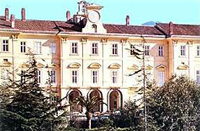|
|
|
 |
|
You can easily reach the ruins of Herculaneum and Pompeii, and also Sorrento on the “Circumvesuviana”, a picturesque and value-for-money local railway. Shopaholics can visit the nearby Torre del Greco, famous all over the world for its production of pearls and coral, while nature-lovers can explore the superb national park of Vesuvius. It is also possible to visit the eighteenth-century Vesuvian Villas which, in Spring often provide the setting for concerts and cultural and literary events. |
|
 |
|
|
 |
 The Royal Palace and Chapel The Royal Palace and Chapel
Chosen by the aristocrats of Naples who built their elegant villas on the slopes of Vesuvius, Portici became the favourite spot of the Bourbon Charles III. Enchanted by its natural beauty, he selected it as the site of his summer residence. In 1738 work began on a luxurious palace and later on the port of Granatello and the impressive Botanical Gardens with their wealth of rare plants and insects. The adjoining Royal Chapel still houses the organ played by Mozart during his visits to Portici. |
| |
|
|
 |
 The Archaeological excavations of Ercolano The Archaeological excavations of Ercolano
The Archaeological excavations of Ercolano have returned the ruins of the ancient city of Herculaneum, buried under a cloud of ash, lava and mud, during the eruption of Vesuvius in 79, along with Pompeii, Stabiae and Oplontis.
Discovered by chance following the excavations for the construction of a well in 1709, archaeological investigations at Herculaneum began in 1738 to continue, with many interruptions, to a systematic excavation sponsored by Amedeo Maiuri in 1927: most of the finds are housed at the National Archaeological Museum of Naples, while in 2008 the birth of virtual archaeological museum shows the city before the eruption of Vesuvius.
The site of Herculaneum, managed by the Superintendence for Archaeological Heritage of Pompeii, Herculaneum and Stabiae, is visited by an average of three hundred thousand tourists every year: in 1997, along with the ruins of Pompeii and Oplonti, has joined the list of UNESCO World Heritage Sites.
|
| |
|
|
 |
 The Vesuvian Villas and the Golden Mile The Vesuvian Villas and the Golden Mile
The eighteenth-century villas which sprang up around the Royal Palace in Portici, mainly along the coast and known as the Golden Mile, are genuine masterpieces, designed by the most famous architects of the time. With their scent-filled gardens and sunny interiors they represent a fine blend of natural beauty and skilful design.
|
|
 |
 The Port of Granatello The Port of Granatello
In February 1774 work began on the port which cost all of 30,000 ducats and generated considerable commercial activity, becoming one of the busiest ports in the country. Today it makes for a pleasant walk at the heart of the Bay of Naples; fishing boats come and go and there is a flourishing fish market. The two restaurants at the beginning of the promenade are ideal for a leisurely drink, to sample the dishes typical of the area, or simply to enjoy the lively nightlife. |
| |
|
|
 |
 A Railway by the Sea (The Naples-Portici Railway, the factory and museum of Pietrarsa) A Railway by the Sea (The Naples-Portici Railway, the factory and museum of Pietrarsa)
In the past the only way to reach Portici was by coach or, for the wealthy few, on horseback, but on 3rd October 1839 the Naples-Portici railway - the first Italian railway - was inaugurated. The inhabitants of Portici are still proud of this record. But that is not all. The Bourbon King Ferdinand wished to make his kingdom independent of the British companies who at the time had a monopoly on steam engines. The factories of Pietrarsa were the beginnings of the first industrial centre in the area: the machines, boilers and engines which were manufactured and repaired there supplied the whole kingdom. It was in Pietarsa that the huge statue of King Ferdinand, which now dominates the square in front of the factory, was cast.
The splendid carriages of the time are housed in the Museum of Pietrarsa.
|
|
|
|
|
|
|
